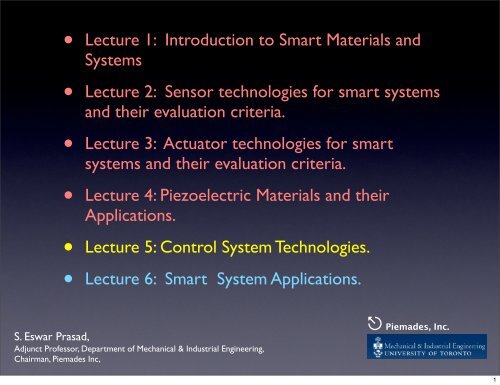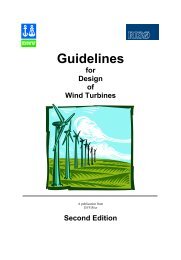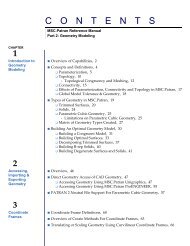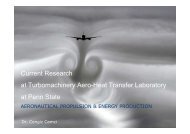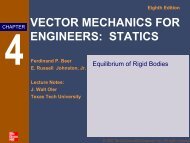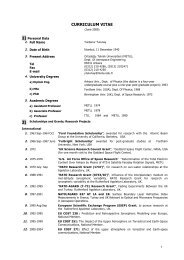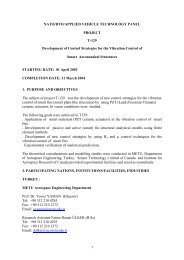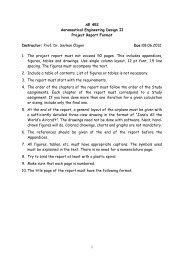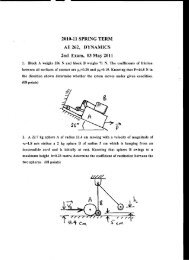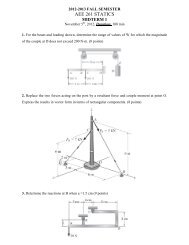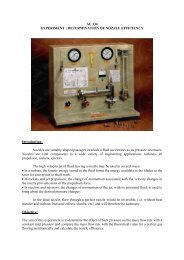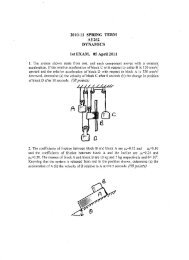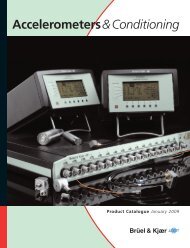2012 METU Lecture 5 Control of Smart Systems - Department of ...
2012 METU Lecture 5 Control of Smart Systems - Department of ...
2012 METU Lecture 5 Control of Smart Systems - Department of ...
You also want an ePaper? Increase the reach of your titles
YUMPU automatically turns print PDFs into web optimized ePapers that Google loves.
•<br />
•<br />
•<br />
•<br />
•<br />
•<br />
<strong>Lecture</strong> 1: Introduction to <strong>Smart</strong> Materials and<br />
<strong>Systems</strong><br />
<strong>Lecture</strong> 2: Sensor technologies for smart systems<br />
and their evaluation criteria.<br />
<strong>Lecture</strong> 3: Actuator technologies for smart<br />
systems and their evaluation criteria.<br />
<strong>Lecture</strong> 4: Piezoelectric Materials and their<br />
Applications.<br />
<strong>Lecture</strong> 5: <strong>Control</strong> System Technologies.<br />
<strong>Lecture</strong> 6: <strong>Smart</strong> System Applications.<br />
S. Eswar Prasad,<br />
Adjunct Pr<strong>of</strong>essor, <strong>Department</strong> <strong>of</strong> Mechanical & Industrial Engineering,<br />
Chairman, Piemades Inc,<br />
⎋ Piemades, Inc.<br />
1
<strong>Control</strong> Technologies<br />
for <strong>Smart</strong> <strong>Systems</strong><br />
S. Eswar Prasad,<br />
Adjunct Pr<strong>of</strong>essor, <strong>Department</strong> <strong>of</strong> Mechanical & Industrial Engineering,<br />
Chairman, Piemades Inc,<br />
⎋ Piemades, Inc.<br />
2
<strong>Control</strong> Technologies for <strong>Smart</strong> <strong>Systems</strong><br />
• <strong>Control</strong> <strong>Systems</strong> Overview<br />
Open loop and closed loop systems<br />
• <strong>Control</strong> System Characteristics<br />
Steady State, Transient Response and Stability<br />
• <strong>Control</strong>ler Operation<br />
Proportional, Compensated<br />
• Digital <strong>Control</strong> <strong>Systems</strong><br />
<strong>Control</strong> algorithms, implementation, hardware<br />
• <strong>Control</strong> System Design<br />
3<br />
3
<strong>Control</strong> <strong>Systems</strong> Overview<br />
•<br />
•<br />
•<br />
•<br />
Deals with influencing the behaviour <strong>of</strong> dynamic systems<br />
Interdisciplinary field, which originated in engineering and<br />
mathematics, and evolved into use by the social sciences, like<br />
psychology, sociology, criminology and in financial systems.<br />
<strong>Control</strong> systems have four basic functions; Measure,<br />
Compare, Compute, and Correct.<br />
These four functions are completed by three elements;<br />
Sensors, Actuators, <strong>Control</strong> System. In a smart system, these<br />
three elements are typically contained in one unit.<br />
4
<strong>Control</strong> <strong>Systems</strong> Overview<br />
Definition <strong>of</strong> a <strong>Smart</strong> System<br />
5
<strong>Control</strong> <strong>Systems</strong> Overview<br />
Historical<br />
Feedback control (Bode,1945)<br />
Theory <strong>of</strong> Stochastic Processes (Weiner, 1930)<br />
Root Locus Theory (Evans, 1948)<br />
Modern <strong>Control</strong> (1950s, Kalman, Bellman, Pontryagin)<br />
• Root locus theory remains an important technique today.<br />
• Suitable for design and stability analysis.<br />
Root locus analysis is a graphical method for examining how the<br />
roots <strong>of</strong> a system change with variation <strong>of</strong> a certain system<br />
parameter, commonly the gain <strong>of</strong> a feedback system. This is a<br />
technique used in the field <strong>of</strong> control systems developed by Walter<br />
R. Evans.<br />
6
<strong>Control</strong> <strong>Systems</strong> Overview<br />
Root locus approach<br />
Assumption<br />
The definition <strong>of</strong> the damping ratio and natural frequency<br />
presumes that the overall feedback system is well approximated by<br />
a second order system, that is, the system has a dominant pair <strong>of</strong><br />
poles.<br />
Uses<br />
• Determine the stability <strong>of</strong> the system<br />
• Design for the damping ratio and natural frequency <strong>of</strong> a<br />
feedback system.<br />
• Lag, lead, PI, PD and PID controllers can be designed<br />
approximately with this technique.<br />
7
<strong>Control</strong> <strong>Systems</strong> Overview<br />
•<br />
•<br />
•<br />
Example: cruise control <strong>of</strong> a car<br />
Cruise <strong>Control</strong> is a device designed to<br />
maintain vehicle speed at a constant desired<br />
or reference speed provided by the driver.<br />
The controller is the cruise control, the plant<br />
is the car, and the system is the car and the<br />
cruise control. The system output is the car's<br />
speed, and the control itself is the engine's<br />
throttle position which determines how<br />
much power the engine generates.<br />
8
<strong>Control</strong> System Technology<br />
•<br />
•<br />
Method-1. Implement cruise control by simply locking the<br />
throttle position when the driver engages cruise control.<br />
However, if the cruise control is engaged on a stretch <strong>of</strong> flat<br />
road, then the car will travel slower going uphill and faster<br />
when going downhill.<br />
Method-2. Use the system output (the car's speed) to<br />
control the throttle position. As a result, the controller can<br />
compensate for changes acting on the car, like a change in<br />
the slope <strong>of</strong> the road.<br />
9
<strong>Control</strong> <strong>Systems</strong> Overview<br />
Types <strong>of</strong> <strong>Control</strong> systems<br />
• Open Loop <strong>Control</strong><br />
• Closed Loop <strong>Control</strong><br />
10
Open Loop System<br />
•<br />
•<br />
Reference<br />
Input<br />
<strong>Control</strong>ler<br />
Actuating<br />
Signal<br />
<strong>Control</strong>led Process<br />
(Plant)<br />
General block diagram <strong>of</strong> an open-loop system<br />
<strong>Control</strong>led<br />
Variable<br />
(output)<br />
An open-loop controller is <strong>of</strong>ten used in simple processes<br />
because <strong>of</strong> its simplicity and low cost, especially in systems<br />
where feedback is not critical<br />
An open-loop controller, also called a non-feedback controller,<br />
is a type <strong>of</strong> controller that computes its input into a system<br />
using only the current state and its model <strong>of</strong> the system.<br />
11
Open Loop System<br />
Reference<br />
Input<br />
•<br />
•<br />
<strong>Control</strong>ler<br />
Actuating<br />
Signal<br />
<strong>Control</strong>led Process<br />
(Plant)<br />
General block diagram <strong>of</strong> an open-loop system<br />
<strong>Control</strong>led<br />
Variable<br />
(output)<br />
A characteristic <strong>of</strong> the open-loop controller is that it<br />
does not use feedback to determine if its output has<br />
achieved the desired goal <strong>of</strong> the input. This means that<br />
the system does not observe the output <strong>of</strong> the<br />
processes that it is controlling.<br />
It also may not compensate for disturbances in the<br />
system.<br />
12
Open Loop System<br />
Reference<br />
Input<br />
•<br />
<strong>Control</strong>ler<br />
Actuating<br />
Signal<br />
<strong>Control</strong>led Process<br />
(Plant)<br />
General block diagram <strong>of</strong> an open-loop system<br />
<strong>Control</strong>led<br />
Variable<br />
(output)<br />
Typical examples: Washing Machine, for which the length <strong>of</strong><br />
machine wash time is entirely dependent on the judgment<br />
and estimation <strong>of</strong> the human operator. Some Irrigation<br />
Sprinklers are programmed to turn on/<strong>of</strong>f at set times. It<br />
does not measure soil moisture as a form <strong>of</strong> feedback. Even if<br />
rain is pouring down on the lawn, the sprinkler system would<br />
activate on schedule, wasting water.<br />
13
Closed Loop System<br />
Reference<br />
Input<br />
Error<br />
Detector<br />
+ -<br />
Feedback<br />
Signal<br />
Error<br />
Signal<br />
<strong>Control</strong>ler<br />
Actuating<br />
Signal<br />
Feedback Path Elements<br />
<strong>Control</strong>led<br />
Process<br />
(Plant)<br />
General block diagram <strong>of</strong> a closed-loop control system<br />
<strong>Control</strong>led<br />
Variable<br />
(output)<br />
A closed-loop controller uses feedback to control states or outputs<br />
<strong>of</strong> a dynamical system. Its name comes from the information path in<br />
the system: Process inputs have an effect on the process outputs,<br />
which is measured with sensors and processed by the controller;<br />
the result (the control signal) is used as input to the process, closing<br />
the loop.<br />
14
Error<br />
Detector<br />
Closed Loop System<br />
Reference<br />
Input<br />
Signal<br />
<strong>Control</strong>ler<br />
Closed-loop controllers have the following advantages over open-loop<br />
controllers:<br />
• Reduce error (eliminating the error)<br />
• Reduce sensitivity or Enhance robustness<br />
• Disturbance rejection or elimination<br />
• Improve dynamic performance or adjust the transient response (such as<br />
reduce time constant) rejection (such as unmeasured friction in a motor)<br />
+ -<br />
Feedback<br />
Signal<br />
• unstable processes can be stabilized<br />
• improved reference tracking performance<br />
Error<br />
Actuating<br />
Signal<br />
Feedback Path Elements<br />
<strong>Control</strong>led<br />
Process<br />
(Plant)<br />
General block diagram <strong>of</strong> a closed-loop control system<br />
<strong>Control</strong>led<br />
Variable<br />
15
Closed Loop System<br />
•<br />
•<br />
•<br />
•<br />
•<br />
Examples <strong>of</strong> Closed Loop <strong>Systems</strong><br />
An air conditioning system or a heating system in a house.<br />
The mouse on a computer<br />
A joystick on a video game<br />
Reference<br />
Input<br />
<strong>Control</strong>ler<br />
The speed control (cruise control) on an automobile.<br />
+ -<br />
Feedback<br />
Signal<br />
Error<br />
Error<br />
Signal<br />
Actuating<br />
Signal<br />
Feedback Path Elements<br />
<strong>Control</strong>led<br />
Process<br />
(Plant)<br />
General block diagram <strong>of</strong> a closed-loop control system<br />
<strong>Control</strong>led<br />
Variabl<br />
16
Closed Loop System<br />
Sensor<br />
The output <strong>of</strong> the system y(t) is fed back through a sensor<br />
measurement F to the reference value r(t). The controller C<br />
then takes the error e (difference) between the reference and the<br />
output to change the inputs u to the system under control P.<br />
This kind <strong>of</strong> controller is a closed-loop controller or feedback<br />
controller.<br />
This is called a single-input-single-output (SISO) control system;<br />
MIMO (i.e., Multi-Input-Multi-Output) systems, with more than one<br />
input/output, are common. In such cases variables are represented<br />
through vectors instead <strong>of</strong> simple scalar values.<br />
17
Closed Loop System<br />
Sensor<br />
If we assume the controller C, the plant P, and the sensor F are linear and timeinvariant<br />
(i.e., elements <strong>of</strong> their transfer function C(s), P(s), and F(s) do not depend on<br />
time), the systems above can be analyzed using the Laplace transform on the<br />
variables. This gives the following relations:<br />
Solving for Y(s) in terms <strong>of</strong> R(s) gives:<br />
18
Closed Loop System<br />
The expression<br />
Sensor<br />
is referred to as the closed-loop transfer function <strong>of</strong> the system. The numerator is<br />
the forward (open-loop) gain from r to y, and the denominator is one plus the gain in<br />
going around the feedback loop, the so-called loop gain. If , i.e., it has a large norm<br />
with each value <strong>of</strong> s, and if ,<br />
then Y(s) is approximately equal to R(s) and the output closely tracks the reference<br />
input.<br />
19
Selection <strong>of</strong> a <strong>Control</strong> System<br />
Trade-<strong>of</strong>fs<br />
An open-loop<br />
system<br />
• Simplicity and low cost<br />
• Complexity and higher cost<br />
A closed-loop<br />
system<br />
20
Elements <strong>of</strong> <strong>Control</strong> <strong>Systems</strong> Response Characteristics<br />
• Steady State Response<br />
• Transient Response<br />
• Stability<br />
21
Elements <strong>of</strong> <strong>Control</strong> <strong>Systems</strong> Response Characteristics<br />
Steady State Response is defined as the output <strong>of</strong> the plant.<br />
Difference between final value and the desired value is known as<br />
the steady-state error.<br />
Amplitude<br />
Input Command<br />
Overshoot<br />
Transient Response<br />
Time<br />
Steady State Response<br />
Steady State<br />
Error<br />
22
Elements <strong>of</strong> <strong>Control</strong> <strong>Systems</strong> Response Characteristics<br />
Transient Response is defined as the change undergone by plant from<br />
time input is applied to the time taken to reach steady state. The ideal<br />
situation is to reach the final state accurately and in as little time as<br />
possible.<br />
Four parameters define the transient response.<br />
Amplitude<br />
Input Command<br />
Overshoot<br />
Transient Response<br />
Time<br />
Steady State Response<br />
Steady State<br />
Error<br />
23
Elements <strong>of</strong> <strong>Control</strong> <strong>Systems</strong> Response Characteristics<br />
Amplitude<br />
Input Command<br />
Overshoot<br />
Transient Response<br />
Settling time, ts, is the time it takes output to settle within a specified boundary<br />
typically 2%).<br />
Rise time, tr, is the time it takes for the output to change from 10% to 90% <strong>of</strong> final<br />
value.<br />
Peak time, tp, is the time to reach the vicinity <strong>of</strong> set point, and usually the largest,<br />
peak.<br />
Overshoot, Mp, is the amount that the peak exceeds the steady state value at the<br />
peak time. generally expressed as a percentage <strong>of</strong> the final steady state value.<br />
Time<br />
Steady State Response<br />
Steady State<br />
Error<br />
24
Elements <strong>of</strong> <strong>Control</strong> <strong>Systems</strong> Response Characteristics<br />
• Stability is defined as the ability <strong>of</strong> a control system to<br />
achieve its goal without going into oscillation.<br />
• The total response <strong>of</strong> a control system is a combination<br />
<strong>of</strong> the natural response, totally governed by the plant,<br />
and the forced response, typically governed by the<br />
controller.<br />
• It is a mandatory requirement that a control system be<br />
stable.<br />
25
Open loop<br />
Closed Loop<br />
Step response <strong>of</strong> a control system<br />
26
Elements <strong>of</strong> <strong>Control</strong> <strong>Systems</strong> Response Characteristics<br />
Considering a second order system, we can derive expressions for<br />
the terms using the pole location parameters ζ and ωn.<br />
27
Elements <strong>of</strong> <strong>Control</strong> <strong>Systems</strong> Response Characteristics<br />
Considering a second order system, we can derive expressions for<br />
the terms using the pole location parameters ζ and ωn.<br />
28
<strong>Control</strong>ler Operation<br />
<strong>Control</strong>ler provides a means to allow the output <strong>of</strong> a system to<br />
track the input. Using frequency domain analysis methods, the<br />
transfer function can be expressed as,<br />
Ideally , Y(s)=1, and the output tracks input perfectly. <strong>Control</strong>lers<br />
are broadly classified into two types.<br />
• Proportional <strong>Control</strong>lers<br />
• Compensated <strong>Control</strong>lers<br />
29
Proportional <strong>Control</strong>lers<br />
In the proportional control algorithm, the controller output is<br />
proportional to the error signal, which is the difference between<br />
the set point and the process variable. In other words, the output<br />
<strong>of</strong> a proportional controller is the multiplication product <strong>of</strong> the<br />
error signal and the proportional gain.<br />
This can be mathematically expressed as<br />
where<br />
Pout: Output <strong>of</strong> the proportional controller<br />
Kp: Proportional gain<br />
e(t): Instantaneous process error at time 't'. e(t) = SP − PV<br />
SP: Set point<br />
PV: Process variable<br />
30
Compensated <strong>Control</strong>lers<br />
• Compensation is a technique used to change the root locus so<br />
that it passes through a desired pole position.<br />
• This process involves the selective positioning <strong>of</strong> additional<br />
poles and zeros into the overall response <strong>of</strong> the system.<br />
• Compensation can be used to improve both the steady state<br />
error and the transient response.<br />
• Most controllers now are implemented digitally.<br />
31
PID <strong>Control</strong>lers<br />
A proportional–integral–derivative controller (PID controller) is a<br />
generic control loop feedback mechanism (controller) widely used<br />
in industrial control systems – a PID is the most commonly used<br />
feedback controller. A PID controller calculates an "error" value as<br />
the difference between a measured process variable and a desired<br />
set point. The controller attempts to minimize the error by<br />
adjusting the process control inputs.<br />
u(t)<br />
+<br />
-<br />
P<br />
+<br />
e(t)<br />
+<br />
∑ ∑ Plant/Process<br />
I<br />
D<br />
+<br />
y(t)<br />
32
PID <strong>Control</strong>lers<br />
• The PID controller calculation (algorithm) involves three separate constant<br />
parameters, the proportional, the integral and derivative values, denoted P, I, and<br />
D.<br />
• These values can be interpreted in terms <strong>of</strong> time: P depends on the present<br />
error, I on the accumulation <strong>of</strong> past errors, and D is a prediction <strong>of</strong> future<br />
errors, based on current rate <strong>of</strong> change. The weighted sum <strong>of</strong> these three<br />
actions is used to adjust the process via a control element.<br />
• In the absence <strong>of</strong> knowledge <strong>of</strong> the underlying process, a PID controller is the<br />
best controller. By tuning the three parameters in the PID controller algorithm,<br />
the controller can provide control action designed for specific process<br />
requirements.<br />
• The the use <strong>of</strong> the PID algorithm for control does not guarantee optimal<br />
control <strong>of</strong> the system or system stability.<br />
CONTROL SYSTEMS, ROBOTICS, AND AUTOMATION – Vol. II - PID <strong>Control</strong> - Araki M.<br />
http://en.wikipedia.org/wiki/Special:BookSources/9-780863412998<br />
http://en.wikipedia.org/wiki/PI_controller#PI_controller<br />
33
PID <strong>Control</strong>lers<br />
In PID control the sum <strong>of</strong> its three correcting terms constitutes<br />
the manipulated variable (MV). The proportional, integral, and<br />
derivative terms are summed to calculate the output <strong>of</strong> the PID<br />
controller. Defining u(t) as the controller output, the final form <strong>of</strong><br />
the PID algorithm is:<br />
where<br />
Kp : Proportional gain, a tuning parameter<br />
Ki : Integral gain, a tuning parameter<br />
Kd : Derivative gain, a tuning parameter<br />
e : Error = SP − PV<br />
t : Time or instantaneous time (the present)<br />
34
PID <strong>Control</strong>lers<br />
u(t)<br />
+<br />
P<br />
+<br />
e(t)<br />
+<br />
∑ ∑ Plant/Process<br />
-<br />
Parameter Rise Time Overshoot Settling Time<br />
I<br />
D<br />
+<br />
Steady-state<br />
Error<br />
y(t)<br />
Stability<br />
Kp Decrease Increase Small Change Decrease Degrade<br />
Ki Decrease Increase Increase<br />
Kd<br />
Small Increase<br />
Small<br />
decrease<br />
Small<br />
decrease<br />
Large<br />
decrease<br />
No effect in<br />
theory<br />
Ang, K.H., Chong, G.C.Y., and Li, Y. (2005) PID control system analysis, design, and technology.<br />
IEEE Transactions on <strong>Control</strong> <strong>Systems</strong> Technology, 13 (4). pp. 559-576.<br />
Jinghua Zhong (2006). PID <strong>Control</strong>ler Tuning: A Short Tutorial.<br />
Degrade<br />
Improve if Kd<br />
is small<br />
35
PID <strong>Control</strong>lers<br />
Open Loop step response (OL) Proportional <strong>Control</strong> (P) Proportional Derivative control (PD)<br />
http://www.engin.umich.edu/group/ctm/PID/PID.html<br />
Proportional Integral control (PI) Proportional-Integral-Derivative <strong>Control</strong> (PID)<br />
36
PID <strong>Control</strong>lers - Limitations<br />
• While PID controllers are applicable to many control problems,<br />
and <strong>of</strong>ten perform satisfactorily without any improvements or<br />
even tuning, they can perform poorly in some applications, and<br />
do not in general provide optimal control.<br />
• The fundamental difficulty with PID control is that it is a<br />
feedback system, with constant parameters, and no direct<br />
knowledge <strong>of</strong> the process, and thus overall performance is<br />
reactive and a compromise.<br />
37
PID <strong>Control</strong>lers - Limitations<br />
• PID controllers, when used alone, can give poor performance<br />
when the PID loop gains must be reduced so that the control<br />
system does not overshoot, oscillate or hunt about the control<br />
set point value.<br />
• PID controllers have difficulties in the presence <strong>of</strong> nonlinearities,<br />
may trade-<strong>of</strong>f regulation versus response time, do not<br />
react to changing process behaviour (say, the process changes<br />
after it has warmed up), and have lag in responding to large<br />
disturbances.<br />
38
PID <strong>Control</strong>lers - Limitations & Solutions<br />
• While PID control is the best controller with no model <strong>of</strong> the<br />
process, better performance can be obtained by incorporating a<br />
model <strong>of</strong> the process.<br />
• The most significant improvement is to incorporate feedforward<br />
control with knowledge about the system, and using<br />
the PID only to control error.<br />
• PIDs can also be modified in more minor ways, such as by<br />
changing the parameters (either gain scheduling in different use<br />
cases or adaptively modifying them based on performance),<br />
improving measurement (higher sampling rate, precision, and<br />
accuracy, and low-pass filtering if necessary), or cascading<br />
multiple PID controllers.<br />
39
Design <strong>of</strong> <strong>Control</strong> <strong>Systems</strong> - Process<br />
Objectives<br />
• To aid the product or process - the mechanism, the robot, the<br />
chemical plant, the aircraft, etc to do its job.<br />
• Optimize performance for stability, disturbance regulation,<br />
tracking accuracy or reduction <strong>of</strong> the effects <strong>of</strong> parameter<br />
variations.<br />
40
Design <strong>of</strong> <strong>Control</strong> <strong>Systems</strong> - Process Steps<br />
• Understand the process and its performance requirements.<br />
• Select the number and type <strong>of</strong> sensor(s) considering the<br />
location, technology and noise.<br />
• Select the number and types <strong>of</strong> actuators considering the<br />
location, technology, noise and power.<br />
• Develop a linear model <strong>of</strong> the process, actuator and sensor.<br />
• Design a compensated controller.<br />
• Test, modify and re-test.<br />
Feedback <strong>Control</strong> <strong>of</strong> dynamic <strong>Systems</strong>, Franklin, Powell and Emami-Naeini, 2006 Prentice-Hall.<br />
41
Design <strong>of</strong> <strong>Control</strong> <strong>Systems</strong> - Analogue <strong>Systems</strong><br />
• Typically consist <strong>of</strong> an operational amplifier based active filter<br />
with either lowpass or bandpass characteristics.<br />
• Responses are governed by available filter types - Bessel,<br />
Chebyshev and Butterworth.<br />
• Low pass compensators also known as lag compensators or PI<br />
(Proportional Integral) controllers.<br />
• Bandpass networks are referred as lead-lag compensators or<br />
PID controllers.<br />
42
Design <strong>of</strong> <strong>Control</strong> <strong>Systems</strong> - Digital <strong>Systems</strong><br />
Desired<br />
Response<br />
+<br />
+<br />
-<br />
Error<br />
Digital<br />
<strong>Control</strong>ler<br />
Response<br />
Analogueto-Digital<br />
Converter<br />
Digital-to-<br />
Analogue<br />
COnverter<br />
Feedback<br />
Sensor<br />
Response<br />
Digital <strong>Systems</strong> typically mimic analogue varieties.<br />
Plant<br />
Response<br />
Exception is that <strong>of</strong> data conversion <strong>of</strong> both controller output and<br />
feedback signals.<br />
Output<br />
Response<br />
43
Design <strong>of</strong> <strong>Control</strong> <strong>Systems</strong> - Digital <strong>Systems</strong><br />
Advantages<br />
• Easier implementation, since responses can be programmed.<br />
• Parameter drift is eliminated.<br />
• Changes are easy and almost always require no circuit<br />
modifications.<br />
• Reductions in size, power, weight and cost.<br />
• Reliability (easier testing and verification regimes).<br />
44
Design <strong>of</strong> <strong>Control</strong> <strong>Systems</strong> - Digital <strong>Systems</strong><br />
Digital controllers, in addition to PID, provide additional<br />
algorithms.<br />
• Notch Filter<br />
Notch filters are used to control mechanical resonances in a<br />
plant.<br />
• Dead Beat <strong>Control</strong>ler<br />
Deadbeat controller provides very short settling times in a<br />
control system by replacing all <strong>of</strong> the poles in the systems with<br />
poles at the origin.<br />
• Adaptive Filter<br />
Adaptive filters are useful when plant response cannot be<br />
determined due to insufficient information or if it is subjected<br />
to time varying change. Can also be used to characterize an<br />
unknown plant.<br />
45
Algorithm Implementation Considerations<br />
Digital processing systems operate using sampled data instead <strong>of</strong><br />
continuous data as is used in analogue systems. Mathematically,<br />
differential equations are used to model DSP functions.<br />
A DSP contains a MAC or Multiply-Accumulate Instruction. This<br />
allows the multiplication <strong>of</strong> one variable by another and the<br />
subsequent summation <strong>of</strong> the resulting product with the<br />
accumulator, all operations occurring in one processor cycle.<br />
This fact makes DSP processors ideal candidates for medium to<br />
high performance embedded control applications requiring<br />
computation intensive processing.<br />
Two <strong>of</strong> the most important building blocks <strong>of</strong> DSP are FIT and the<br />
IIR filters.<br />
46
Algorithm Implementation Considerations - FIR Filter<br />
"FIR" means "Finite Impulse Response".<br />
They can easily be designed to be "linear phase" (and usually are).<br />
Put simply, linear-phase filters delay the input signal but don’t<br />
distort its phase.<br />
They are simple to implement. On most DSP microprocessors, the<br />
FIR calculation can be done by looping a single instruction.<br />
They are suited to multi-rate applications.<br />
FIR Filters are feedforward filters where the output values are a<br />
function <strong>of</strong> a finite number <strong>of</strong> past input values.<br />
FIR filters tend to be used where pass band characteristics are<br />
specified. These include the start and end <strong>of</strong> passband and ripple.<br />
47
Algorithm Implementation Considerations - IIR Filter<br />
IIR means "Infinite Impulse Response".<br />
The impulse response is "infinite" because there is feedback in the<br />
filter.<br />
IIR filters can achieve a given filtering characteristic using less<br />
memory and calculations than a similar FIR filter.<br />
They are however more susceptible to problems <strong>of</strong> finite-length<br />
arithmetic, such as noise generated by calculations, and limit cycles.<br />
They are harder (slower) to implement using fixed-point<br />
arithmetic.<br />
They don't <strong>of</strong>fer the computational advantages <strong>of</strong> FIR filters for<br />
multirate (decimation and interpolation) applications.<br />
48
Algorithm Implementation Considerations - Filter Comparison<br />
IIR FIR<br />
More efficient Less efficient<br />
Analog equivalent No analog equivalent<br />
May be unstable Always stable<br />
Non-liner phase response Linear phase response<br />
No efficiency gained by<br />
decimation<br />
Decimation increases<br />
efficiency<br />
49
<strong>Control</strong> System Hardware Implementation<br />
Sensor<br />
Input<br />
condition<br />
Desired<br />
Response<br />
Input<br />
• The heart <strong>of</strong> the controller is the processor.<br />
• It is <strong>of</strong>ten single chip device.<br />
Digital<br />
Signal<br />
Processor<br />
Plant<br />
• There are three types:<br />
microcontrollers, microprocessors<br />
DSPs.<br />
Code/Data<br />
Memory<br />
Output<br />
condition<br />
Functional Diagram <strong>of</strong> a DSP based <strong>Control</strong>ler<br />
Driver<br />
50
<strong>Control</strong> System Hardware Implementation - Microcontrollers<br />
• Microcontrollers are single chip devices with a low to medium<br />
performance core, a basic for <strong>of</strong> I/O (input/output), memory.<br />
• Processors do not contain any inherent mathematical type<br />
functions. complex operations must be performed with simpler<br />
arithmetic, logical, and data move functions.<br />
• Can be used in low performance applications. best suited for<br />
high volume, simple function control systems that do not<br />
demand high performance.<br />
• Cost is relatively low.<br />
• Examples are: PIC family, Motorola 68H series and Intel 8051<br />
series.<br />
51
<strong>Control</strong> System Hardware Implementation - Microprocessors<br />
• Microprocessors are generally low to high performance devices<br />
that rely on external I/O peripherals and memory for proper<br />
operation.<br />
• Operational speeds are higher than microcontrollers.<br />
• More complex instructions are available as well as some floating<br />
point arithmetic on the chip or as a processor.<br />
• can be used in low to moderate performance control systems,<br />
including ancillary functions such as human-machine interfaces.<br />
• Cost is moderate to high.<br />
• Examples are Motorola’s 68000 and Power PC families; AMD<br />
Opteron family, Cypress Semiconductor PSoC family and Intel<br />
i960 family.<br />
52
<strong>Control</strong> System Hardware Implementation - DSPs<br />
• DSPs are high performance processors, optimized for<br />
computational efficiency.<br />
• built in ports for interfacing with ADCs and DACs and other<br />
processors.<br />
• Data can be represented in fixed point or floating point<br />
formats. Programs can be loaded from eternal memory.<br />
• Handle moderate to high performance control systems.<br />
• Cost is low to moderate.<br />
• Examples are Analog Devices 21xx family, Texas Instruments<br />
C6000 family and Motorola 96000 family.<br />
53
<strong>Control</strong> System Hardware Implementation - Factors<br />
• Sensor input<br />
dynamic range, sampling rate, number <strong>of</strong> sensor inputs<br />
interface, polled or interrupt driven.<br />
• <strong>Control</strong> algorithm<br />
fixed point or floating point, computational performance<br />
requirements, data storage requirement, program storage<br />
requirement.<br />
• <strong>Control</strong>ler output considerations<br />
Same as sensor input.<br />
• Cost and Schedule<br />
COST versus product development.<br />
54
<strong>Control</strong> System Hardware Implementation - Typical Plant Parameters<br />
Parameter Sensing Method<br />
Position<br />
Speed<br />
Acceleration<br />
Potentiometer (linear or angular)<br />
LVDT (Linear)<br />
Resolver (Angular)<br />
Optical Encoder (Linear or Angular)<br />
Tachometer (RPM to voltage)<br />
Hall Effect (Frequency)<br />
Optical Encoder (Frequency)<br />
Piezoelectric Accelerometer<br />
Strain Gage Accelerometer<br />
55
<strong>Control</strong> System Hardware Implementation - Typical Plant Parameters<br />
Parameter Sensing Method<br />
Temperature<br />
Pressure<br />
Force<br />
Flow Rate<br />
Thermocouple<br />
Semiconductor Junction<br />
Thermisotr<br />
Strain Gage<br />
Piezoelectric Force Transducer<br />
Strain Gage<br />
Piezoelectric Force Transducer<br />
Differential Pressure<br />
Impeller (Frequency)<br />
Thermal (Differential temperature)<br />
56
<strong>Control</strong> System Hardware Implementation - Factors<br />
LNA<br />
BPF<br />
DSP Input Schematic Diagram<br />
VGA<br />
ADC<br />
VGA <strong>Control</strong><br />
from DSP<br />
• Input Signal Conditioning<br />
Amplification <strong>of</strong> sensor signals, filtered, variable gain amplifier for<br />
adjustment, analogue to digital converter and interface to DSP.<br />
• <strong>Control</strong>ler Response<br />
local control - no operator inout<br />
control by another processor through a port - interactive<br />
control<br />
Data to<br />
DSP<br />
57
<strong>Control</strong> System Hardware Implementation - Factors<br />
Data<br />
from DSP<br />
<strong>Control</strong><br />
from DSP<br />
DAC<br />
PWM<br />
DSP Output Schematic Diagram<br />
Plant<br />
Drive<br />
• <strong>Control</strong>ler Output<br />
Output signal is converted back to analogue signal with a DAC,<br />
filtered, fed to power amplifier.<br />
LPF<br />
Buffer<br />
PA<br />
PA<br />
Plant<br />
Drive<br />
58
<strong>Control</strong> System Hardware Implementation - Method<br />
• Translate the system requirements into a design specification<br />
• Translate the design specification into a functional block<br />
diagram.<br />
• Optimize the block diagram.<br />
• Translate the block diagram into a mathematical model.<br />
• Optimize the mathematical model.<br />
59
<strong>Control</strong> System Hardware Implementation - Block Diagram<br />
60
<strong>Control</strong> System Hardware Implementation - Case Studies<br />
• Computer Hard disk <strong>Control</strong> System.<br />
This case study demonstrates the ability to perform classical<br />
digital control design by going through the design <strong>of</strong> a<br />
computer hard-disk read/write head position controller.<br />
• Automobile Active Suspension System.<br />
The vehicle suspension system is responsible for driving<br />
comfort and safety as the suspension caries the vehicle body<br />
and transmits all forces between the body and the road. By<br />
adding an active suspension comfort and safety are<br />
considerably improved compared to suspension setups with<br />
fixed properties.<br />
61
Hard Disc Drive Description<br />
62
Hard Disc Drive Description<br />
• Disk read/write heads are the small parts <strong>of</strong> a disk drive, that move<br />
above the disk platter and transform platter's magnetic field into<br />
electrical current (read the disk) or vice versa – transform electrical<br />
current into magnetic field (write the disk)<br />
• They are high-precision, high- performance machines produced in very<br />
high volumes and sold at relatively low cost.<br />
63
Performance <strong>of</strong> a Hard Disc Drive<br />
There are three ways to measure the performance <strong>of</strong> a hard disk:<br />
• Data Rate – The data rate is the number <strong>of</strong> bytes per second<br />
that the drive can deliver to the CPU. Rates between 5 and 40<br />
megabytes per second are common.<br />
• Seek Time – The seek time is the amount <strong>of</strong> time between<br />
when the CPU requests a file and when the first byte <strong>of</strong> the file<br />
is sent to the CPU. Times between 10 and 20 milliseconds are<br />
common.<br />
• Capacity - The other important parameter is the capacity <strong>of</strong> the<br />
drive, which is the number <strong>of</strong> bytes it can hold.<br />
64
Hard Disc Drive Description<br />
• In a hard drive, the heads 'fly' above the disk surface with clearance <strong>of</strong> as<br />
little as 3 nanometres. The "flying height" is constantly decreasing to<br />
enable higher areal density. The flying height <strong>of</strong> the head is controlled by<br />
the design <strong>of</strong> an air-bearing etched onto the disk-facing surface <strong>of</strong> the<br />
slider. The role <strong>of</strong> the air bearing is to maintain the flying height constant<br />
as the head moves over the surface <strong>of</strong> the disk. If the head hits the disk's<br />
surface, a catastrophic head crash can result.<br />
66
Hard Disc Drive Construction Details<br />
Platters <strong>of</strong> a Hard disc Hard disc head<br />
The microphotograph <strong>of</strong> the head shows that the size <strong>of</strong> the front face<br />
is about 0.3 mm. One functional part <strong>of</strong> the head is the round, orange<br />
structure in the middle - the lithographically defined copper coil <strong>of</strong> the<br />
write transducer.<br />
67
Hard Disc Drive Description<br />
• The plates are manufactured to amazing tolerances and are mirrorsmooth<br />
and typically spin at 3,600 or 7,200 rpm when the drive is<br />
operating.<br />
• The light and fast-moving arm holds the read/write heads and is<br />
controlled by the voice-coil actuator. The arm is able to move the<br />
heads from the hub to the edge <strong>of</strong> the drive and can do this, back<br />
and forth, up to 50 times per second.<br />
• In order to keep the magnetic head as close to the disk surface as<br />
possible, a self-pressurized air-bearing design is used for the sliders.<br />
68
Design Challenges<br />
• To design each <strong>of</strong> the four main components <strong>of</strong> the disk drive<br />
servo system – plant dynamics, sensors, actuators, and control<br />
algorithms – and to reduce the effect <strong>of</strong> mechanical disturbances<br />
to the drive.<br />
• Disturbances arise from many sources: external shocks and<br />
vibrations, mechanical imperfections in the bearings <strong>of</strong> the disk<br />
spindle, disk vibrations, turbulent flow over the actuator due to<br />
air currents generated by the rapidly spinning disks, and the<br />
occasional contact between the slider and the disk.<br />
• Plant dynamics which affect servo performance are mechanical<br />
resonances in the suspension (the leaf spring that holds the head<br />
against the disk), the actuator arm, the pivot bearing, and the<br />
voice coil.<br />
69
Design Challenges<br />
• The pivot bearing also has nonlinear friction dynamics, which<br />
include hysteresis and which primarily affect seek performance.<br />
• Flutter vibration modes in the disks and other modes in the<br />
spindle contribute to tracking errors by moving the data track<br />
relative to an inertial frame <strong>of</strong> reference.<br />
• Noise and distortion are two other important sources <strong>of</strong><br />
tracking error in disk drives. Noise arises not only from<br />
electronics, but also from the magnetic media.<br />
• The magnetoresistive head readers are nonlinear devices.<br />
• Quantization noise is, <strong>of</strong> course, present in this digital control<br />
system.<br />
70
Functional Block Diagram<br />
71
Computer Hard Disc Drive - Transfer Function<br />
Using Newton's law, a simple model for the read/write head is the<br />
differential equation:<br />
where J is the inertia <strong>of</strong> the head assembly, C is the viscous damping<br />
coefficient <strong>of</strong> the bearings, K is the return spring constant, Ki is the<br />
motor torque constant, θ is the angular position <strong>of</strong> the head, and i is<br />
the input current.<br />
Taking the Laplace transform, the transfer function from i to θ is<br />
Using the values J = 0.01 kg m 2 , C = 0.004 Nm/(rad/sec), K = 10 Nm/<br />
rad, and Ki = 0.05 Nm/rad, form the transfer function description <strong>of</strong> this<br />
system.<br />
Transfer function:<br />
72
<strong>Control</strong> System Performance<br />
Step Response with large Phase margin Step response with filter<br />
Step response with controller implemented<br />
73
Active Suspension <strong>Systems</strong> - Introduction<br />
Active or adaptive suspension technology controls the<br />
vertical movement <strong>of</strong> the wheels with an onboard system<br />
rather than the movement being determined entirely by<br />
the road surface.<br />
The system virtually eliminates body roll and pitch<br />
variation in many driving situations including cornering,<br />
accelerating, and braking.<br />
This technology allows car manufacturers to achieve a<br />
greater degree <strong>of</strong> ride quality and car handling by keeping<br />
the tires perpendicular to the road in corners, allowing<br />
better traction and control.<br />
74
<strong>Control</strong> System Hardware Implementation -<br />
Active Suspension <strong>Systems</strong> Studies<br />
• The vehicle suspension system is responsible for<br />
driving comfort and safety as the suspension caries<br />
the vehicle body and transmits all forces between the<br />
body and the road.<br />
• Active systems enable the suspension system to<br />
adapt to various driving conditions. By adding a<br />
variable damper and/or spring, driving comfort and<br />
safety are considerably improved compared to<br />
suspension setups with fixed properties.<br />
75
Suspension <strong>Systems</strong> - Safety and Stability Issues<br />
• Safety is the result <strong>of</strong> a good suspension design in terms <strong>of</strong><br />
wheel suspension, springing, steering, and braking, and is<br />
reflected in an optimal dynamic behaviour <strong>of</strong> the vehicle.<br />
• Tire load variation is an indicator for the road contact and can<br />
be used for determining a quantitative value for safety.<br />
• Driving comfort results from keeping the physiological stress<br />
that the vehicle occupants are subjected to by vibrations, noise,<br />
and climatic conditions down to as low a level as possible.<br />
• The acceleration <strong>of</strong> the body is an obvious quantity for the<br />
motion and vibration <strong>of</strong> the car body and can be used for<br />
determining a quantitative value for driving comfort.<br />
76
Suspension <strong>Systems</strong> - Conflicting Criteria<br />
• In order to improve the ride quality, it is necessary to isolate<br />
the body.<br />
• To improve the ride stability, it is important to keep the tire in<br />
contact with the road surface.<br />
• For a given suspension spring, the better isolation <strong>of</strong> the sprung<br />
mass from road disturbances can be achieved with a s<strong>of</strong>t<br />
damping by allowing a larger suspension deflection.<br />
• Better road contact can be achieved with a hard damping<br />
preventing unnecessary suspension deflections.<br />
Therefore, the ride quality and the drive stability are two<br />
conflicting criteria.<br />
77
Suspension <strong>Systems</strong> - Currently Available <strong>Systems</strong><br />
• Currently three types <strong>of</strong> vehicle suspensions are used: passive,<br />
semi-active, and active.<br />
• <strong>Systems</strong> implemented in automobiles today are based on<br />
hydraulic or pneumatic operation.<br />
• These solutions do not satisfactorily solve the vehicle oscillation<br />
problem, or they are very expensive and increase the vehicle’s<br />
energy consumption.<br />
• Significant improvement <strong>of</strong> suspension performance is achieved<br />
by active systems, however, they are expensive and complex.<br />
78
Suspension <strong>Systems</strong> - Model<br />
Inputs<br />
The system has ten inputs, six <strong>of</strong> which are exogenous and the others<br />
controllable. These inputs are:<br />
• Exogenous:<br />
The road velocity inputs experienced at each wheel<br />
Vehicle pitch force (due to accelerating/braking/cornering the vehicle)<br />
Vehicle roll input (due to cornering the vehicle)<br />
• <strong>Control</strong>lable:<br />
Actuator forces applied to the suspension system at each corner <strong>of</strong><br />
the vehicle.<br />
• Outputs<br />
The ride quality can be quantified by examining the vertical and angular<br />
accelerations <strong>of</strong> the vehicle body, as well as the ability for the vehicle to<br />
remain level regardless <strong>of</strong> operating conditions.<br />
79
Suspension <strong>Systems</strong> - Operating Scenarios for<br />
modelling<br />
1. Driving over a speed bump (generates a vertical<br />
velocity pr<strong>of</strong>ile input).<br />
2. Braking at 1 g by applying the appropriate pitch<br />
moment to the vehicle centre <strong>of</strong> gravity.<br />
3. Cornering by applying the appropriate pitch and roll<br />
moment to the vehicle centre <strong>of</strong> gravity.<br />
80
Suspension <strong>Systems</strong> - LQR Models<br />
Design <strong>of</strong> an LQR <strong>Control</strong> Strategy for Implementation on a Vehicular Active Suspension System<br />
Ben Creed, Nalaka Kahawatte, Scott Varnhagen 2010 – University <strong>of</strong> California, Davis<br />
81
Suspension <strong>Systems</strong> - Bose System<br />
• The Bose system uses a linear electromagnetic motor (LEM) at<br />
each wheel in lieu <strong>of</strong> a conventional shock- and-spring setup.<br />
Amplifiers provide electricity to the motors in such a way that<br />
their power is regenerated with each compression <strong>of</strong> the<br />
system.<br />
• The main benefit <strong>of</strong> the motors is that they are not limited by<br />
the inertia inherent in conventional fluid-based dampers. As a<br />
result, an LEM can extend and compress at a much greater<br />
speed, virtually eliminating all vibrations in the passenger cabin.<br />
• The wheel's motion can be so finely controlled that the body <strong>of</strong><br />
the car remains level regardless <strong>of</strong> what's happening at the<br />
wheel. The LEM can also counteract the body motion <strong>of</strong> the car<br />
while accelerating, braking, and cornering, giving the driver a<br />
greater sense <strong>of</strong> control.<br />
82
Bose Active Suspension System<br />
83
Active Suspension <strong>Systems</strong><br />
Bose Active Suspension<br />
84
Active Suspension <strong>Systems</strong><br />
The Siemens eCorner project<br />
The eCorner concept replaces the conventional wheel suspension with hydraulic shock<br />
absorbers, mechanical steering, hydraulic brakes and internal combustion engines with<br />
integrated in-wheel systems<br />
85
Resources<br />
Feedback <strong>Control</strong> <strong>of</strong> Dynamic <strong>Systems</strong>, Gene Franklin, David<br />
Powell and Abbas Emami-Naeini, Pearson Prentice-Hall, 2006.<br />
Feedback <strong>Control</strong> <strong>Systems</strong>, Charles Phillips and Royce Harbour,<br />
Prentice-Hall, 2000.<br />
Mechatronics, G.S. Hegde, Jones and Bartlett Publishers LLC, 2010.<br />
Introduction to Mechatronics and Measurement <strong>Systems</strong>, A.<br />
Alciatore and M. Histand, McGraw Hill, 2003.<br />
86
•<br />
•<br />
•<br />
•<br />
•<br />
•<br />
<strong>Lecture</strong> 1: Introduction to <strong>Smart</strong> Materials and<br />
<strong>Systems</strong><br />
<strong>Lecture</strong> 2: Sensor technologies for smart systems<br />
and their evaluation criteria.<br />
<strong>Lecture</strong> 3: Actuator technologies for smart<br />
systems and their evaluation criteria.<br />
<strong>Lecture</strong> 4: Piezoelectric Materials and their<br />
Applications.<br />
<strong>Lecture</strong> 5: <strong>Control</strong> System Technologies.<br />
<strong>Lecture</strong> 6: <strong>Smart</strong> System Applications.<br />
S. Eswar Prasad,<br />
Adjunct Pr<strong>of</strong>essor, <strong>Department</strong> <strong>of</strong> Mechanical & Industrial Engineering,<br />
Chairman, Piemades Inc,<br />
⎋ Piemades, Inc.<br />
87


